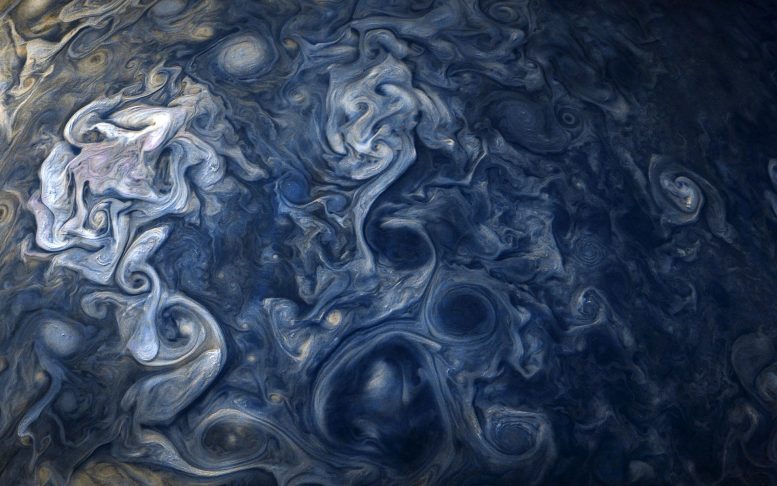
Cloud system in Jupiter’s northern hemisphere imaged by Juno spacecraft. New research shows similarities between Earth’s atmospheric processes and those on Jupiter, helping to understand how Jupiter’s storms are maintained. Credit: NASA
An analysis of NASA satellite images of cyclones on Jupiter reveals that the storms are fueled by processes similar to those acting on Earth.
New research shows that the roiling storms at the planet Jupiter’s polar regions are powered by processes known to physicists studying Earth’s oceans and atmosphere. The geophysical commonalities spanning the 452 million miles between the two planets could even help facilitate an improved understanding of those processes on Earth. The study was led by Lia Siegelman, a physical oceanographer at the University of California, San Diego’s Scripps Institution of Oceanography.
Discovering Earth-like Processes on Jupiter
Siegelman first made the connection between our planet and the gas giant in 2018 when she noticed a striking similarity between images of Jupiter’s huge cyclones and the ocean turbulence she was studying. To a physicist, air and water are both considered fluids so applying ocean physics to Jupiter isn’t as far-fetched as it sounds, said Siegelman. “Jupiter is basically an ocean of gas.”
This initial observation led Siegelman to co-author a 2022 study published in Nature Physics that analyzed high-resolution infrared images of Jupiter’s cyclones taken by NASA’s Juno spacecraft. The analysis revealed that a type of convection similar to what is seen on Earth helps maintain Jupiter’s storms, which can be thousands of miles wide and last for years.
The 2022 study focused directly on Jupiter’s cyclones, but Siegelman also saw wispy tendrils, known to researchers as filaments, in the spaces between the gassy vortices. These filaments also had earthly analogs, and Siegelman used Juno’s detailed imagery to study whether this similarity to our planet’s oceanic and atmospheric processes was merely skin deep.
Understanding Jupiter’s Atmospheric Dynamics
Published today (June 6) in Nature Physics and funded by Scripps and the National Science Foundation, Siegelman’s follow-up study finds additional similarities between the processes fueling Jupiter’s cyclones and those acting on Earth. The study shows that the filaments between Jupiter’s cyclones act in concert with convection to promote and sustain the planet’s giant storms. Specifically, Jupiter’s filaments act in ways that resemble what oceanographers and meteorologists call fronts on Earth.
Fronts are often discussed in weather forecasts – cold fronts or storm fronts, for example – but they apply to both gases and liquids. A front is the boundary between gas or liquid masses with different densities due to differences in properties like temperature. In the ocean, fronts can also be due to differences in salinity, which influences the density of seawater along with temperature. A key feature of fronts is that their leading edges feature strong vertical velocities that can create winds or currents.
Analyzing Infrared Imagery From Juno
To try to understand the role of the filaments she could clearly see in between the cyclones on Jupiter in Juno’s images, Siegelman looked at a series of infrared images from Juno. The batch of images was of Jupiter’s north polar region and they were taken in 30-second increments.
The fact that the images were in infrared allowed Siegelman and her co-author Patrice Klein of NASA’s Jet Propulsion Laboratory, California Institute of Technology, and the Ecole Normale Superieure to calculate temperature – bright areas were warmer and dark areas were cooler. On Jupiter, the hotter parts of the atmosphere correspond to thin clouds and the colder parts represent thick cloud cover, blocking more of the heat emanating from Jupiter’s super-heated core. The researchers then tracked the movement of clouds and filaments across the 30-second intervals separating the photographs to calculate horizontal wind speeds.
Fronts in Jupiter’s Atmosphere
These two pieces of information allowed Siegelman and Klein to apply methods from ocean and atmospheric science to Jupiter, allowing them to calculate the vertical wind speeds that would correspond to the temperatures and horizontal wind speeds the researchers derived from the images. Once the team calculated the vertical wind speeds, they were able to see that Jupiter’s filaments were indeed behaving like fronts on Earth.
Those vertical wind speeds at the edges of fronts on Jupiter also meant that the fronts were involved in transporting energy in the form of heat from the planet’s hot interior to its upper atmosphere – fueling the giant cyclones. Though convection is the main driver, the fronts account for a quarter of the total kinetic energy powering Jupiter’s cyclones and forty percent of the vertical heat transport.
Implications for Understanding Cosmic Phenomena
“These cyclones on Jupiter’s poles have persisted since they were first observed in 2016,” said Siegelman. “These filaments in between the large vortices are relatively small but they are an important mechanism for sustaining the cyclones. It’s fascinating that fronts and convection are present and influential on Earth and Jupiter – it suggests that these processes may also be present on other turbulent fluid bodies in the universe.”
Advances in Visualizing Oceanic Phenomena
Siegelman also said that Jupiter’s massive scale and Juno’s high-resolution imagery can allow for a clearer visualization of the ways in which smaller-scale phenomena like fronts connect to larger ones like cyclones and the atmosphere at large – connections that are often hard to observe on Earth where they are much smaller and more ephemeral. However, she added, a long-awaited new satellite known to researchers as SWOT, is poised to make these kinds of ocean phenomena vastly easier to observe.
“There is some cosmic beauty in finding out that these physical mechanisms on Earth exist on other far-away planets,” said Siegelman.
Reference: “Frontogenesis at Jovian high latitudes” 6 June 2024, Nature Physics.
DOI: 10.1038/s41567-024-02516-x
>>> Read full article>>>
Copyright for syndicated content belongs to the linked Source : SciTechDaily – https://scitechdaily.com/jupiters-colossal-cyclones-driven-by-earth-like-atmospheric-processes/































